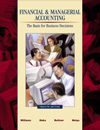Chapter 5 - Summary LO 1 Prepare an Income statement, a statement of retained earnings, and a balance
sheet. The financial statements are prepared directly from the adjusted trial balance.
The income statement is prepared by reporting all revenue earned during the
period, less all expenses incurred in generating the related revenue. The statement
of retained earnings reconciles the beginning Retained Earnings account
balance with its ending balance. The retained earnings statement reports
any increase to Retained Earnings resulting from net income earned for the period,
as well as any decreases to Retained Earnings resulting from dividends declared
or a net loss incurred for the period. The balance sheet reveals the company's
financial position by reporting its economic resources (assets), and the claims
against those resources (liabilities and owners' equity). LO 2 Explain how the Income statement and the statement of retained earnings relate
to the balance sheet. An income statement shows the revenue and expenses of a business for a specified
accounting period. In the statement of retained earnings, the net income figure
from the income statement is added to the beginning Retained Earnings balance,
while dividends declared during the period are subtracted, in arriving at the
ending Retained Earnings balance. The ending Retained Earnings balance is then
reported in the balance sheet as a component of owners' equity. LO 3 Explain the concept of adequate disclosure. Adequate disclosure is a generally accepted accounting principle, meaning that
financial statements should include any information that an informed user needs
to interpret the statements properly. The appropriate disclosures usually are
contained in several pages of notes that accompany the statements. LO 4 Explain the purposes of closing entries; prepare these entries. Closing entries serve two basic purposes. The first is to return the balances
of the temporary owners' equity accounts (revenue, expenses, and dividend accounts)
to zero so that these accounts may be used to measure the activities of the
next reporting period. The second purpose of closing entries is to update the
balance of the Retained Earnings account. Four closing entries generally are
needed: (1) close the revenue accounts to the Income Summary account, (2) close
the expense accounts to the Income Summary account, (3) close the balance of
the Income Summary account to the Retained Earnings account, and (4) close the
Dividends account to the Retained Earnings account. LO 5 Prepare an after-closing trial balance. After the revenue and expense accounts have been closed, it is desirable to
prepare an after-closing trial balance consisting solely of balance sheet accounts.
The after-closing trial balance, or post-closing trial balance, gives assurance
that the accounts of the general ledger are in balance and ready for recording
transactions for the new accounting period. LO 6 Use financial statement Information to evaluate profitability and solvency. Profitability is an increase in stockholders' equity resulting from revenue
exceeding expenses, whereas solvency refers to a company's ability to meet its
cash obligations as they come due. Solvency, at least in the short term, may
be independent of profitability. Financial statements are useful tools
for evaluating both profitability and solvency. Used separately, or in combination,
the income statement and balance sheet help interested parties to measure a
company's current financial performance, and to forecast its profit and cash
flow potential. On page 000, we illustrated several measures of profitability
and solvency computed using financial statement information. Throughout the
remainder of this text we introduce and discuss many additional measures. LO 7 Explain how Interim financial statements are prepared in a business that closes
its accounts only at year-end. When a business closes its accounts only at year-end, the revenue, expense,
and owner's drawing accounts have balances representing the activities of the
year to date. To prepare an income statement for any period shorter than the
year-to-date, we subtract from the current balance in the revenue or expense
account the balance in the account as of the beginning of the desired period.
This process of subtracting prior balances from the current balance is repeated
for each revenue and expense account and for the owner's drawing account. No
computations of this type are required for the balance sheet accounts, as a
balance sheet is based on the account balances at the balance sheet date. LO 8 Prepare a worksheet and explain its usefulness. A worksheet is a "testing ground" on which the ledger accounts are
adjusted, balanced, and arranged in the format of financial statements. A worksheet
consists of a trial balance, the end-of-period adjusting entries, an adjusted
trial balance, and columns showing the ledger accounts arranged as an income
statement and as a balance sheet. The completed worksheet is used as the basis
for preparing financial statements and for recording adjusting and closing entries
in the formal accounting records. In Chapter 5 we have completed our study of the accounting cycle for a service-type
business. We have also completed our continued illustrated example of Overnight
Auto Service. In Chapter 6 we will extend these concepts by focusing on some
additional steps needed to account for inventories of goods sold by wholesale
or retail merchandising businesses. | 


 2002 McGraw-Hill Higher Education
2002 McGraw-Hill Higher Education